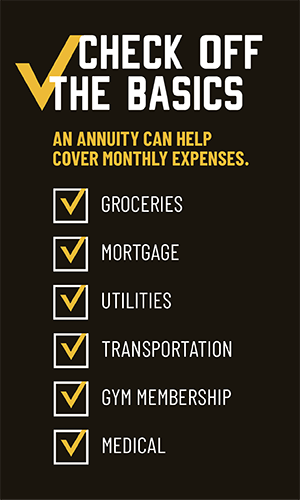CHECK OFF THE BASICS IN RETIREMENT
3 minute read
 Today’s retirement is less about winding down and more about spending time on favorite pursuits and new activities. It’s an exciting next chapter in your life, but planning for it can be confusing. With so many factors to consider when funding retirement, it’s difficult to know where to start. But a new approach — Check Off the Basics — provides a simple starting point that will help make sense of retirement income planning and break the process down into easy-to-understand steps.
Today’s retirement is less about winding down and more about spending time on favorite pursuits and new activities. It’s an exciting next chapter in your life, but planning for it can be confusing. With so many factors to consider when funding retirement, it’s difficult to know where to start. But a new approach — Check Off the Basics — provides a simple starting point that will help make sense of retirement income planning and break the process down into easy-to-understand steps.
The Check Off the Basics approach focuses on finding ways to help cover your essential expenses – things like a mortgage, utilities, groceries and transportation – with protected lifetime income. When you’re able to cover those basic expenses, among other things, you won’t have to worry about running out of income in retirement.
The Check Off the Basics approach is more important now than ever. We’re living longer in our typical retirement years today: In the United States, the life expectancy after age 65 is almost 20 years, compared with about 15 years in 1970, according to United Nations’ statistics. So we need our money to last longer and have enough income to cover our essential expenses for the rest of our lives.
The good news is that annuities work well within the Check Off the Basics approach because they provide protected income throughout your lifetime, typically via monthly payments. Social Security and pensions are the only other sources of protected lifetime income.
Step 1: Determine Your Essential Expenses
As mentioned above, the Check Off the Basics approach emphasizes covering the various essential monthly expenses you often have in retirement. For example, you might not have a mortgage in retirement (though many retirees still have one), but could have rent, condominium fees or other home maintenance costs to consider. Other expenses might include:
- Health care costs such as insurance premiums and medical copays
- Other insurance premiums
- Car loans, leases and maintenance
- Travel expenses such as gas
- Credit card payments
- Any other ongoing expenses you deem essential
Check Off the Basics will change your perspective on retirement planning. Instead of simply accumulating a lump sum of retirement savings, without understanding what you’ll actually need to pay for, you’ll first focus on creating a monthly budget of essential expenses that you already know you’ll have to cover.
You’re basically using a common budgeting approach for this next stage in life. By the way, a financial professional can help you estimate your current essential expenses and how much these expenses will cost in retirement (including the impact of inflation), which will lead to additional discussion about your plans.
Step 2: Plan for Protected Lifetime Income
With that monthly expense number in hand, now you can develop a plan to cover those expenses. Start by combining your estimated monthly benefits from Social Security with any pension payments (if you’re lucky enough to have one) you expect to receive. If that amount is less than your estimated essential monthly expenses, you can bridge that protected income gap with an annuity.
When you’re able to cover your essential expenses with protected lifetime income, you’ll feel secure knowing that your basic needs are taken care of and can use income from your other retirement savings and investments to spend on everything else you wanted to do in retirement. Unlike protected lifetime income from an annuity, returns from investments such as stocks, mutual funds, index funds or bonds can be thought of as potential retirement income, since there are fewer or no guarantees with these investments. Your financial professional can help assess your goals and tolerance for risk as well as determine appropriate investments for this portion of your retirement portfolio.
Check Off the Basics for a Confident Next Chapter in Life
Another benefit of this approach is the feeling of security and reduced stress from knowing you’ll be able to pay your essential expenses with protected lifetime income. In a 2019 study, The American College of Financial Services’ Michael Finke and Wade Pfau, who are also Alliance for Lifetime Income Fellows, found that annuity owners are more confident and feel more freedom to spend and invest.
A 2020 study by the Alliance supports this finding. Among the survey respondents, the 42% of pre-retirees who have other sources of protected income besides Social Security, such as pensions and annuities, are significantly more confident about their ability to cover essential expenses in retirement. In contrast, only 29% of the survey participants are very confident they can cover their essential expenses throughout retirement.
Retirement planning itself can be stressful. But if you cover your essential expenses using protected income, you’ve checked off the basics and can enjoy the life you want in retirement.